Loads of nula
This week: Vertical Gardening; What’s with the weather?; Looking for rocket; Inside jobs; One down, one to go; Loads of nula; Raspberries;
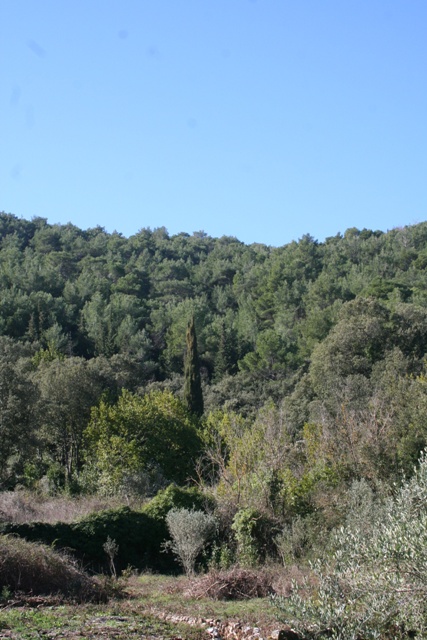
We’ve had a cold wind blowing this week – a bitter Bura which brought March snow to Zagreb – and at the start of the week I spent a bit of time writing my list of “to do” jobs. It came to a total of 21.
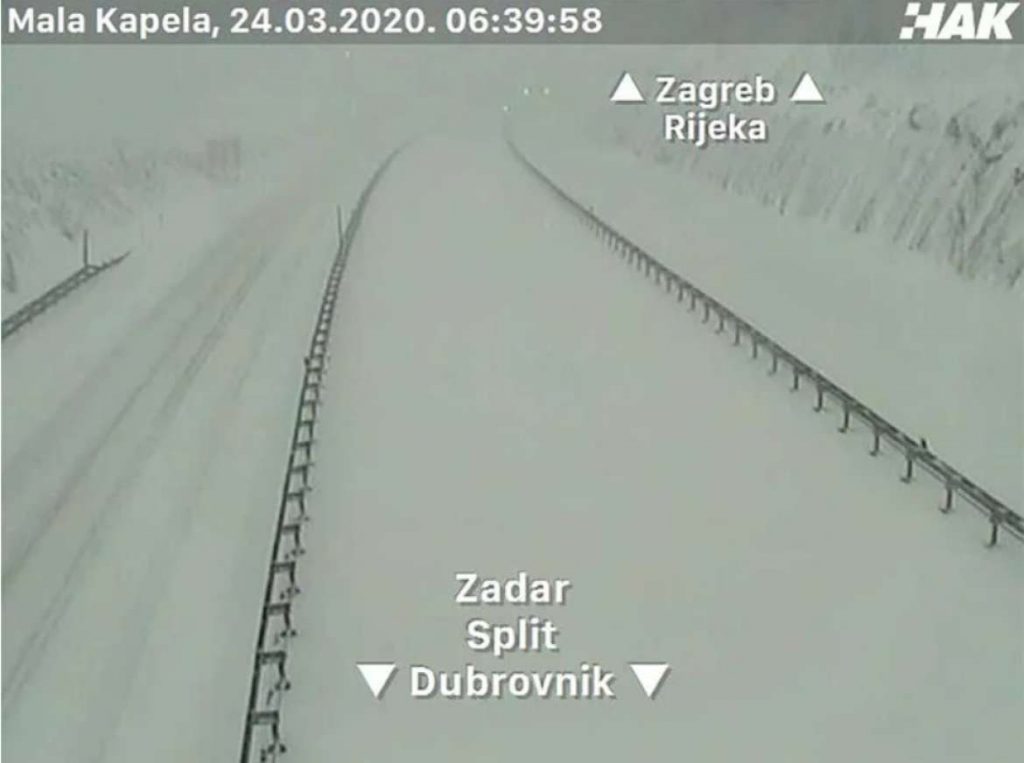
Some were tasks brought forward from last week, some new. When I did my tally on Saturday, I had completed nine tasks.
By the weekend, I have 24 tasks on my list for for next week, so there has been some progress. This is one of those weeks when I have more jobs at the end of the week than when I started.
I’m observing COVID-19 restrictions on movement. This means that the opportunity to take lots of photographs around the villages in this part of Hvar are restricted.
But with many interesting plants in the garden, I’ll be looking more closely at these over the coming weeks.
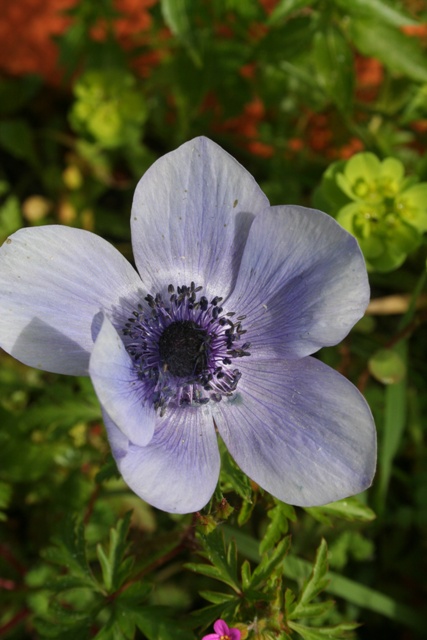
Vertical gardening
I’ve refurbished a small seed starter frame that came from one of my neighbours this week. It wasn’t a long job to wash the plastic cover and mend a couple of tears.

Inside there was an assortment of critters. I disturbed a couple of tiny Tarantellas, the Moorish Gecko, Tarentola mauritanica, which scuttled off into different corners.

These reptiles are comparatively long lived, living for 5 or more years in the wild and up to 15 years in captivity. With scaly bodies, they look like small crocodiles.
I have them both inside and out, one is a permanent resident in my kitchen, where it catch mosquitoes, flies and other insects. They are definitely a gardeners friend.
It’s OK having a seed starter frame, but putting it in the right location is also important. It needs sunshine for at least four hours daily, but preferably not the intense mid-day sun we get in this part of the world.
Against a wall would be an advantage, although it is free standing and above all, somewhere easy to access.
I have the ideal spot, but it is already in use as my nursery area for shrubs. I think I need to look at an alternative location for the nursery because it is the best option for the starter frame.
Not for this year, I already have too many projects on the go, but I would like to experiment with vertical gardening. I have a number of vertical south facing walls which would be ideal for getting early salad crops and herbs growing.
The concept of vertical gardening is something which is developing all the time. With a frame on a wall, a means of irrigating and a supply of seed plugs, all sorts of interesting results can be obtained.
My problem is that I have no shortage of ideas, just a lack of time to do all the things I need to do.
What’s with the weather?
As an emergency planner, when I looked at the unfolding COVID-19 emergency, one of my thoughts was what would happen when the first of the year’s natural disasters strike.
Little did I think we would have much additional worry here in Croatia.
That was shattered just after 06:00 on Sunday morning when there was a 5.3 earthquake in Zagreb, the capital. There was much damage, some serious injuries and even more disruption to life.
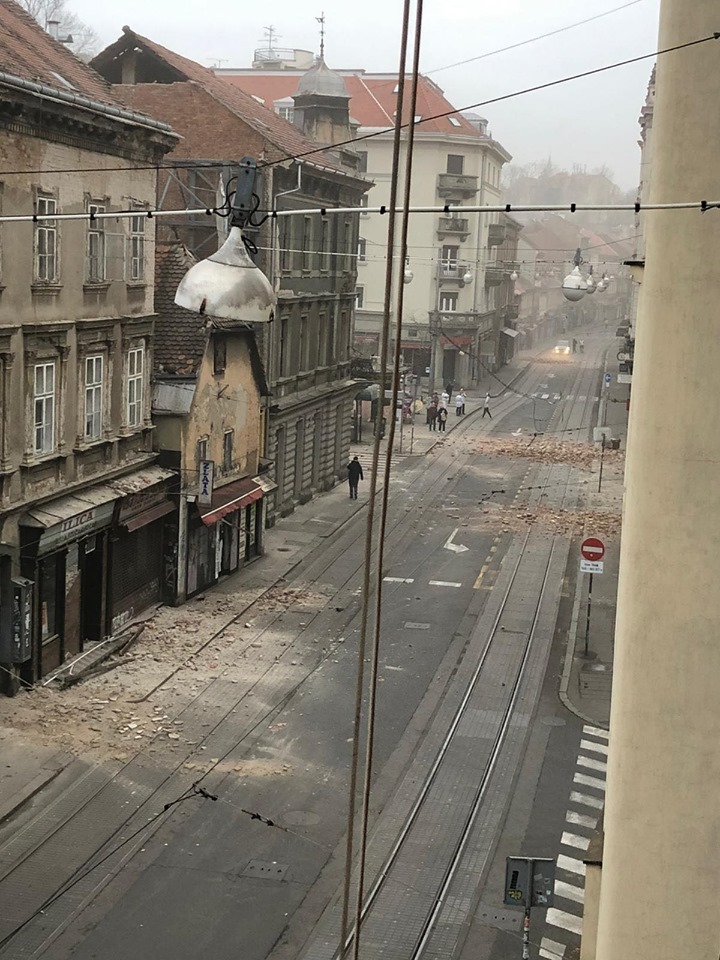
There followed many after shocks including one registering 3.5 on the Richter scale on Monday morning.
But not only that, we had a forest fire here in the south of the island. I could smell the smoke in the air at my Dol house.
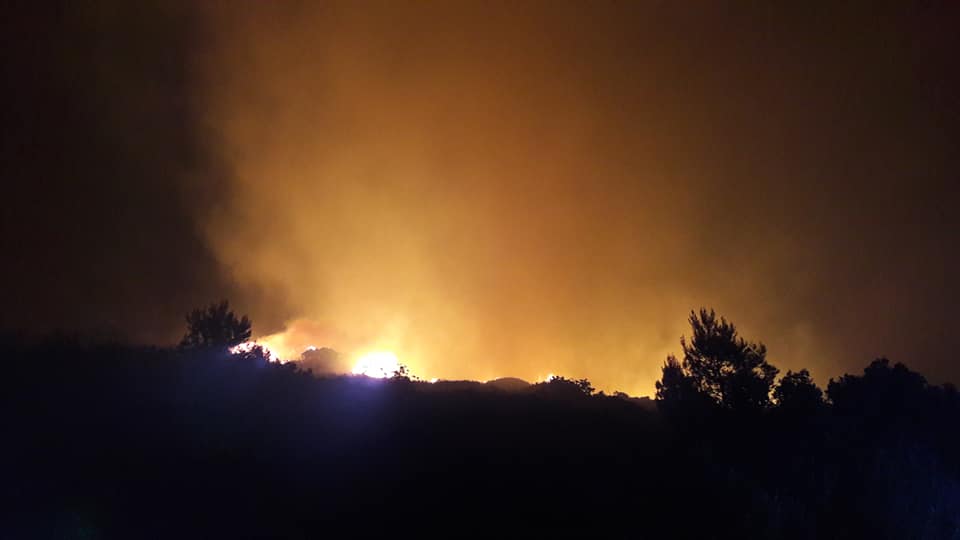
From December we have had an almost completely dry winter, meaning the Maquis and hillsides are all very dry. Major fires this early in the year are just not normal.
My local Vatrogasci in Stari Grad responded along with Jelsa and extinguished the blaze before it became a conflagration.
Then a bitterly cold Bura started to blow. After 12 weeks of above average temperatures, where the days have been around +20ºC and the nights +10ºC, suddenly, in the space of 24 hours, the daytime temperatures were struggling to reach +9ºC.
This week we had consecutive nights where the temperature was only just above zero. With the wind chill, the temperature you feel, not what the thermometer says was below zero. C O L D….
I put fleece round some tender plants, brought others into the greenhouse and hope the fruit blossom has not been damaged.
In the north of the country from Istria to Slavonia and as far south as the border between Kvarner and Dalmatia at Svete Rok there was snow. Deep snow.
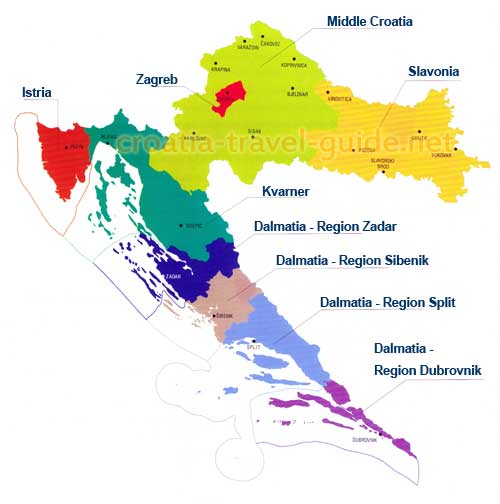
Because of COVID-19 the Government has ordered the population to self isolate at home, except for a few essential tasks like shopping.
On Monday morning they were imploring people NOT to go out in the snow with kids to play, sledge or have snowball fights because of the social distancing.
This is again just another example of the effects of climate change altering the established weather patterns.
Looking for rocket
Not everything I plant goes into seed trays. There are some vegetables and salad crops which can quite happily be sown direct into the soil.
Rocket, Eruca vesicaria, is one such plant.
Rocket goes by various names on different continents. However it is another of the Mediterranean biome herbs which was spread around, first by the Romans and later the marine explorers.
A neighbour gave me some seeds last year. I just had to find them. That wasn’t too difficult as it was in the box of vegetable seeds, in a tube clearly marked “Rucola”.

The leaves have a sweet peppery flavour and contain many essential vitamins and minerals. I like them in a salad or with an omelette.
I have a small bed which last year had sweet potatoes in it. It was fully weeded a few weeks ago.
It’s funny how you remember things from childhood. I remember being taught that when before direct sow seeds, rake the soil to a fine tilth first.
I have an old garden rake from my childhood home which is still going strong.
Then when the soil has a nice friable texture, lay the rake on top and press it into the soil with your foot. When you remove the rake, seeds are sown direct into the impression the handle has left in the soft soil.

So here I am, several thousand kilometres and a few decades later, being transported back to my childhood home in York, doing exactly as I was taught, but sowing Rocket.
After watering the seeds, the first green shoots should be ready for harvest in around four to six weeks. I’ll sow some more at three week intervals to keep me in salad leaves over the summer.
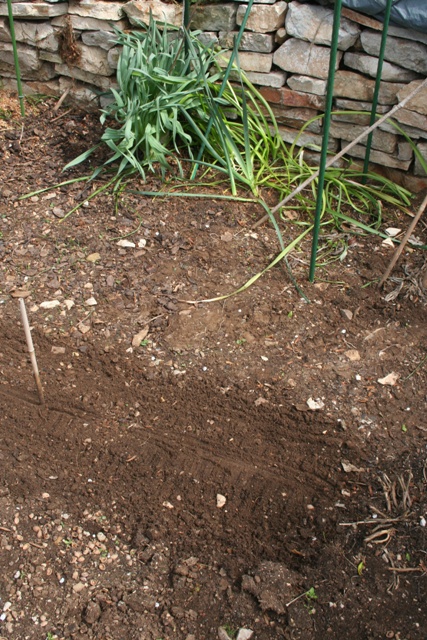
Inside jobs
I’ve decided that I don’t like working in the cold – not at all!
When just a week ago it was shorts and Tee Shirt weather, going back to my thick NATO sweater was not fun. That doesn’t mean I haven’t done any jobs outside, rather, that a number of the tasks I have planned remain on the “to do” list.
Even my felines have been feeling the cold. They have started to lose their winter coats and so have retreated to their individual favourite warm spots to sleep.
Places like the top of the permanently on UPS, in the heated propagator or curled up inside a fluffy towel. I don’t have any coats or sweaters for them to wear. I’ve even had to break out my electric blanket.

One of those jobs which has been waiting for a year has been to fix an antique mirror in the dining room.
I have only fixed one or two things to the walls because quite a bit of the furniture is destined for the lounge, when it is eventually built. However, there was a gap, just the right size for the mirror.
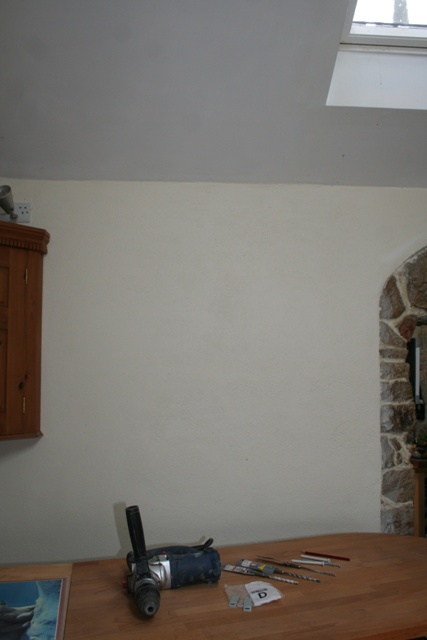
The nice antique gilded mirror which came from the UK has been sitting behind the breakfast bar waiting to be hung. It was originally a mantle shelf mirror, that would have rested at the back of the shelf, above a fire.
Not having any fireplaces, I have no surrounds or mantle shelves. So I needed to make some wooden support brackets for it to sit on. It weighs around 25 kilograms and I simply didn’t trust it just hanging it from a wall hook.
With the brackets carved and painted I carefully measured where it would go on the wall.
This is another of those “problem” walls. Ancient, irregular stone held together with lime mortar, then covered with modern cement render and painted.
You cannot tell when you start to drill, what will be behind the render. It is complete luck whether you find a piece of hard stone or mortar. Or the worst of both worlds, the masonry bit catching the edge of a hard stone and being deflected off, enlarging the hole.
I made the decision to try and fix the base supports first, then when they were firm and secure, to fix the hanging hook.
One down and one to go
Drilling these old walls takes time. Starting with a 4 mm pilot hole I struck rock. I carefully used a 6 mm, a 7 mm then finally an 8 mm SDS wall bit to a depth of 100 mm.
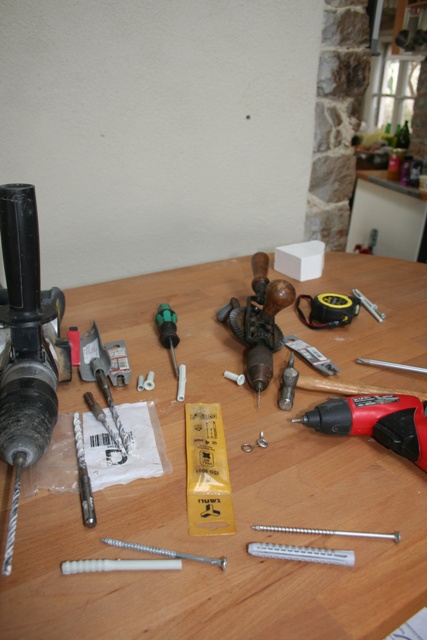
Removing the debris from the hole, I finally slotted the plug into the hole. The block was fixed firmly and tightly to the wall.
The second hole was into pure mortar, then I hit a void. I only drilled to a width of 7 mm because I know how soft the lime mortar is. Unfortunately I couldn’t get the screw to bite on the wall plug and had to think of a different solution.
When I looked at the nylon line that had been used to hang the mirror, I cringed. It was not especially thick although being nylon, it is strong.
I decided to add a pair of flat plates to secure the mirror properly at the top with wall screws, just in case of an earthquake…
Making the brackets for the top of the mirror was easy. On drilling the wall for the plugs, I hit the same problem. One hole went straight into stone and one in soft mortar.
On a shelf in the workshop I have an IKEA box of assorted size plugs. I was worried that I didn’t have any long but thick plugs, however I found I had two 80 x 8 mm in a bubble pack.
To get an 8 mm plug into a 7 mm hole, I cut the web along the length of the plug. This allowed it to compress enough to slide into the 7 mm hole. I gently tapped it into place with a hammer and it was drum tight.
Then using a 120 x 5 mm SPAX screw I secured the wooden support block. Lifting the mirror onto the blocks, then securing it was not hard.
This seemingly simple job has actually taken time – to do it right – and a lot of different tools. But the result is, I think, worth it.

A load of nula
When I lived in Spain, I found that my knowledge of Spanish was OK in some areas, and excellent in others.
One area where I knew almost every term was in the hardware and builders merchants. I find the same here.
Cvjetko phoned me this week to say that his building work has dried up. Construction work is still allowed, because it takes place outside but people don’t want him.
I have the finishing to do on my new building, outside insulation and the waterproof layer. When he asked if I would like him to help with my jobs I said “Yes, definitely“.
I have been doing inside work, but cladding a building is a big job and I know my limitations.
He was very careful to ask if I was comfortable with him coming up. We can keep our social distancing, and two people meeting is still allowed.
I’m happy. Happy because I will get my building into a functional state sooner than I thought and happy that my risk of catching COVID-19 is probably much greater from my neighbour, the district nurse.
On Saturday Cvjetko arrived with a truck load of “Nula”. This is the basic ingredient of almost everything.
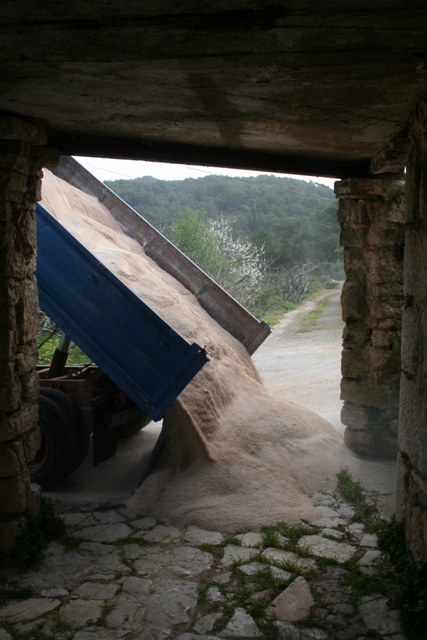
With no sand on the island, crushed and powdered rock is supplied to builders from various quarries. This is then mixed with calcium and cement to make the render which is plastered on internal and external walls.
In Croatian, “nula” means zero. This white crushed stone is as fine as the river or quarried sand that is used in many parts of the world as an ingredient of mortar.
We sat a few meters apart and enjoyed a coffee in the sunshine on my terrace, discussing the current epidemic, but also the Spanish flu of 1918/1919.
His Grandmother was a survivor of that outbreak, but whole families on the island were killed by the virus.
Although my grandparents were from the same generation, Spanish Flu was never a topic of conversation. It is only in recent years when I was reading about the First World War that I became aware of the disease and how many lives the virus took.
This means I have had to re-order my list of work, adding some more jobs and on Saturday I installed a new ring main power cable in the building.
The builder failed to route the conduit for the new incoming mains cable into the wall. It was left trailing like an orange snake across the floor.
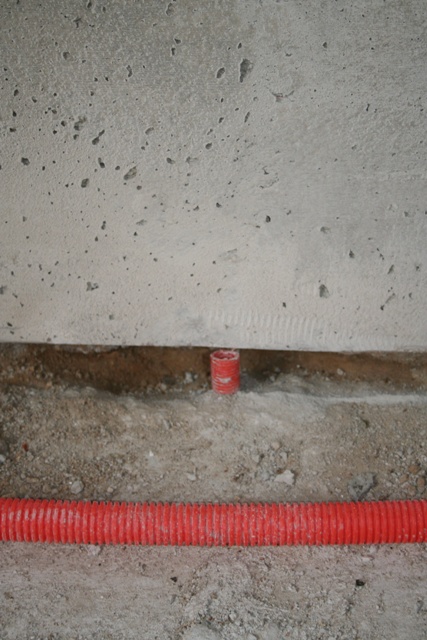
I cut a groove at the bottom of the concrete wall to take the conduit, but in doing so sliced through the ring main cable, because I didn’t know where it ran.
It had been positioned very close to the outside edge of the concrete wall.
I was able to get the mains conduit behind, then using a cable puller, I brought the new mains cable through. This is why I have laid every cable inside a plastic conduit tube, throughout the house.

Who knows what changes there will be over the next 50 years? Things like Ethernet are already being replaced with fibre optics.
Someone in the future may need to change cables in my Dol house. They will find that the wiring can easily be changed.
Raspberries
I do like raspberries.
I’m not especially bothered whether they are fresh or some I have frozen, but they are a really nice fruit to have with ice cream on a warm summer day.
I should add that I also like warm summer days, not like this week!
Over the past few years I have experimented with probably eight or nine different varieties, of which all but two have failed to thrive.
Not to put too finer point on it, they have all died.
Partly because of my poor soils, but also the lack of summer rain and the heat, I have not had the success I was hoping for.
Raspberries can’t stand being water logged, so last year I turned the ideal planting of rasps in a soil mound on it’s head.
I made a shallow trough, with enriched soil and covered it with polythene so every drop of rain would be fed to the roots, together with a drip irrigation system.
All my efforts were a failure. The 2019 planting has not survived to this spring.
Then last winter I came across a new variety which is said to be drought tolerant, so I ordered half a dozen to try.
What I have found with some trees is that they benefit from being kept in big plant pots or tubs. During their first year they establish an extensive root system.
From being bare rooted saplings, they develop into nice young trees with a strong root system. They can then be planted in the orchards during their winter dormant period.
More than once I have bought a bare rooted sapling, planted it into a prepared hole in the orchard and despite all the TLC I can provide, it hasn’t survived its first season.
So this spring I am trying the same technique with the raspberries. After being kept in water until bud burst, this week I planted them.
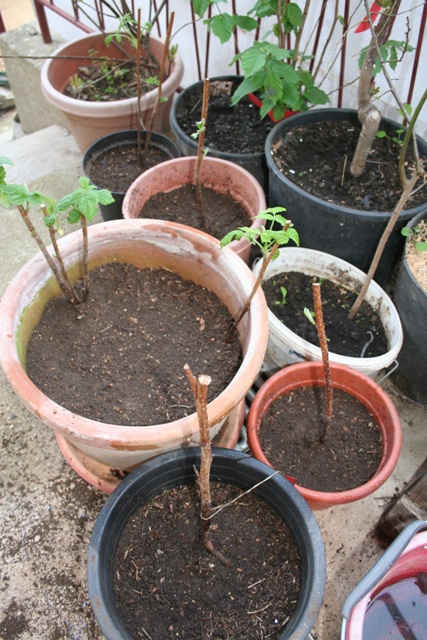
They have each gone into a large pot, where I can control light and moisture in the hope that they develop a strong root system and get acclimatised to the Dol climate. Then, providing they have developed a good root system, they will be planted with the other soft fruits this winter. NRC
oOo
“Line up and sit to attention you ‘orrible lot” Screeched the RFM (Regimental Feline Major)

One Response
Marcy Fletchall
Loved all of your pictures especially the flower and your new vertical garden. Considering one myself. Your mirror is beautiful.
Take care, stay safe and sanitize.marcy